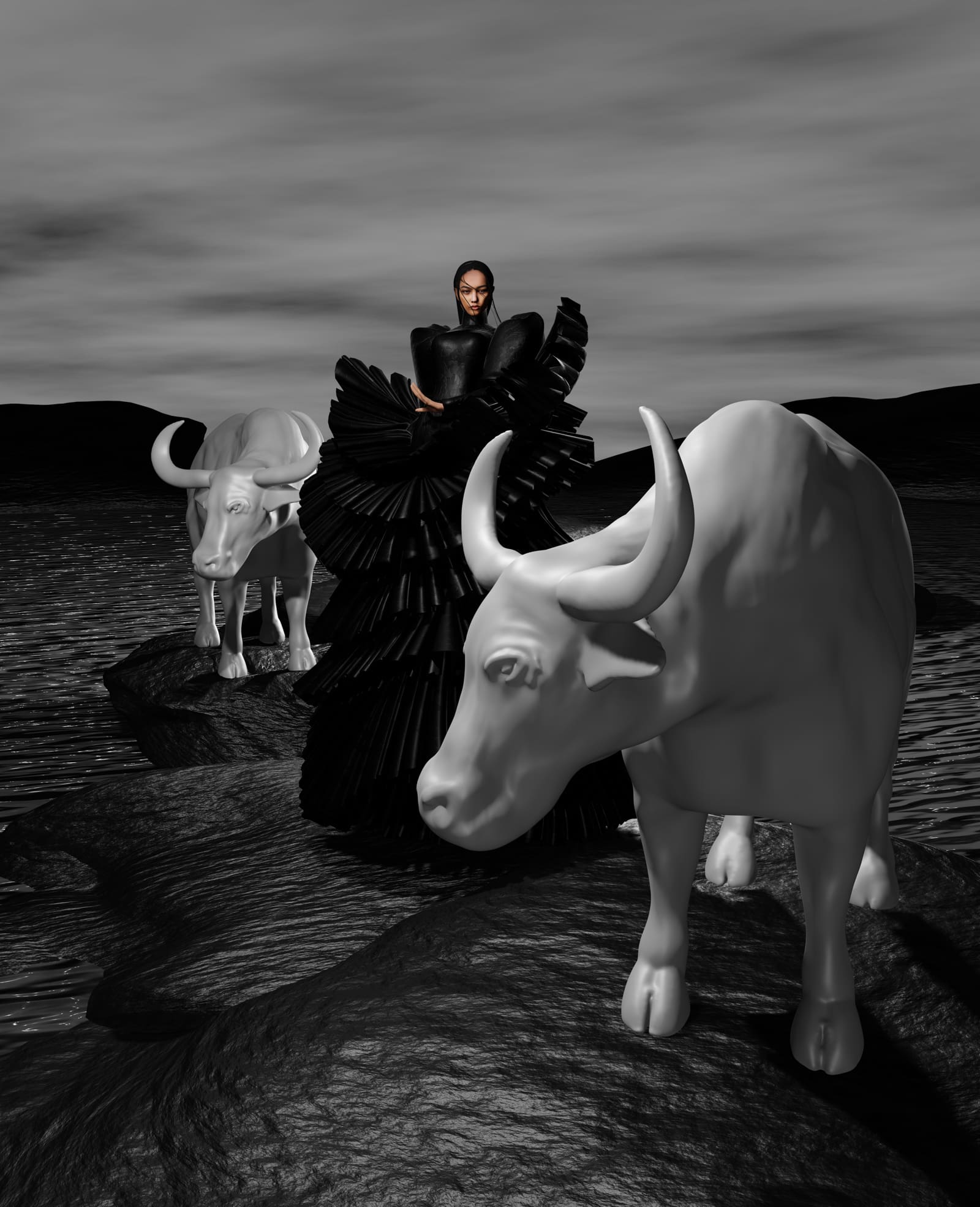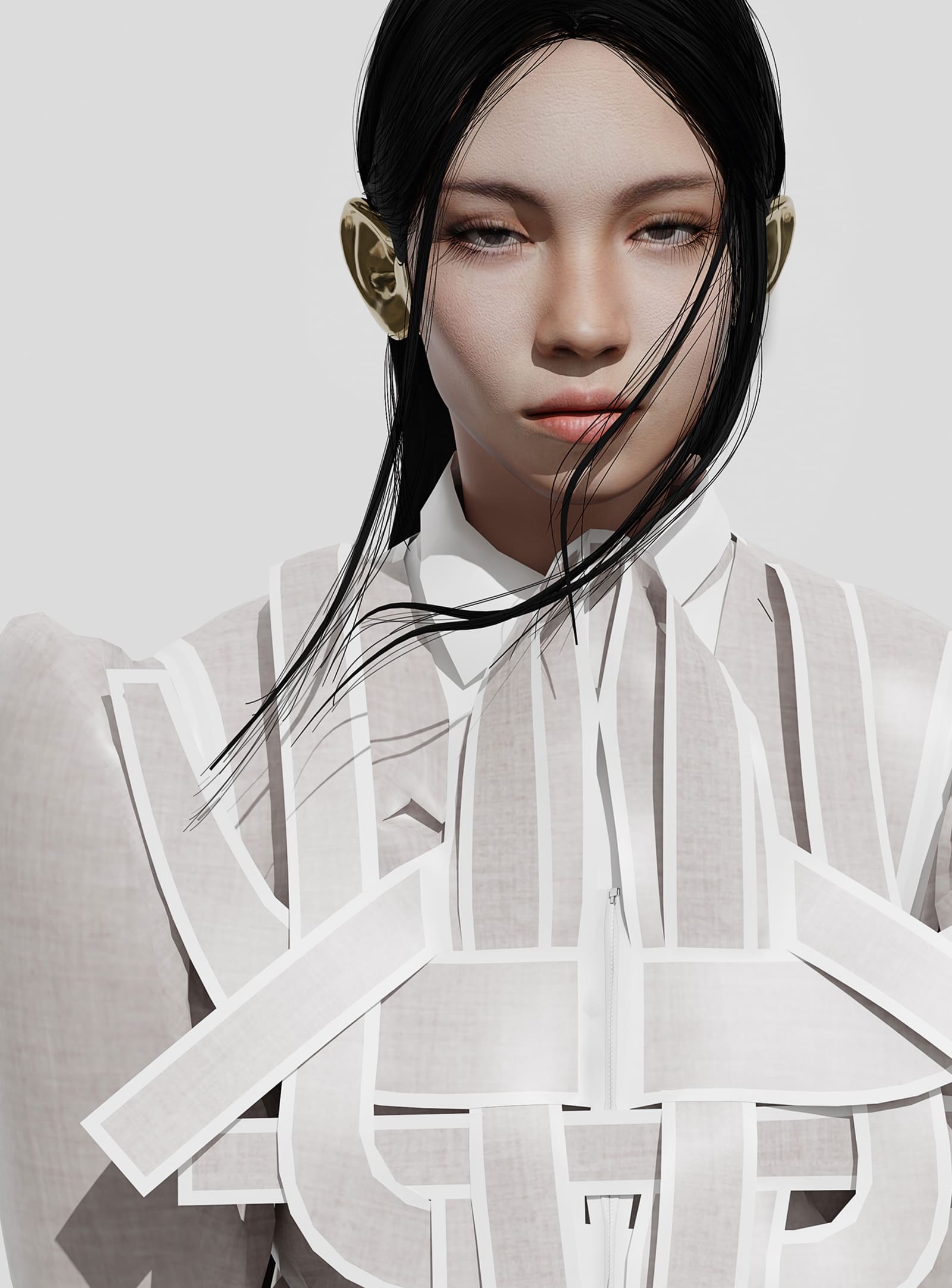Bon Hansen Reyes balintawak. Ivan Medrano.
A digital designer specializing in digital fashion and meta-art, Ivan Medrano harnesses the power of the metaverse to build relationships and explore his identity.
Before discussing a topic as elaborate and polarizing as the metaverse, it is crucial to define the terms, to jump off from a common ground. This is why I ask Ivan Medrano, a Negros Occidental-based digital designer, to explain the virtual realm to me as if I were nine years old.
“I’d give you some candy first so you would like me better,” he teases. Then earnestly, the 21-year-old continues, “I wouldn’t say the word ‘metaverse’ because I feel like people get very scared.” Instead, he would lead with a juxtaposition of the physical world and the virtual world: “I would name all the video games that [kids] probably play [like] Roblox, Minecraft, or Fortnite. [Then I would explain that] there’s a virtual world that you transport to.”
His brief is elementary and accurate enough: the metaverse is a digital social sphere where avatars—humans’ digital selves—can come together and access experiences like virtual and augmented realities.
Learning Curve
This is a universe that the designer has embraced in multiple facets of his life. As of writing, Ivan is in the tail end of completing his Design Bachelor’s Degree, majoring in Visual and Spatial Design at Edith Cowan University. The latter half of his university studies was completed from home in the Philippines, but prior, he would attend in-person classes in Western Australia where he was born and raised to Filipino parents.
Shifting arrangements no longer faze the young artist; his early life was spent moving from place to place in support of a parent’s occupation, one that led him to attending four high schools and ten schools in total.
“Looking back, I think it’s an experience that I’m really grateful and really thankful for. I learned a lot about the human experience and youth culture,” he claims with a smile.
He was drawn to the arts in his formative years, and applied the passion in high school through traditional artforms like watercolor painting, oil painting, and graphite sketching, mediums that he realized, later on, clashed with his tendency to modify a piece’s artistic direction midway through completion. “I was always looking for something that could adjust and change as my ideas adjusted and changed,” Ivan tells Vogue Philippines. “Something that could keep up with my artistic vision.”
On one of many lockdowns in 2020, a fateful scroll through TikTok led him to a timelapse of a 3D design process. The malleability and fluidity of the practice resonated with him, and he soon found himself installing Blender, a free 3D software.
“I think the peripheral skills around digital fashion are things that I studied academically,” he says. Equipped with educational training in digital art and traditional fashion design, he preferred not to seek out formal courses for digital fashion design. What he knows now, he accumulated through what he calls “human-oriented places where people come and share knowledge” like YouTube, TikTok, and Reddit.

Collective Instinct
By December of 2021, he had drafted models and looks for his inaugural digital fashion collection dubbed “Season One: First Impact,” an assemblage of what would become his signature patent black garments on amorphously-sculpted bodies.
And yet, there was no local 3D fashion community that he knew of to share this with.
“I think it does exist but I think people don’t think it exists,” the designer explains. “Me saying that, as someone who’s into fashion into art, is proof that there is a lack of awareness. [We have] a visual identity, but it’s still in the soil. It’s still crude, it needs to be mined out, it needs to be brought out and shared with the world.”
While a Filipino or Philippine-based metafashion collective is yet to sprout, Ivan is inspired by fellow young creatives all over the globe. His eye is sharp for emerging artists with a “solid visual identity” that he can grow with. His metaversal partnerships traverse through continents, and thanks to social media, he counts Los Angeles-based traditional jewelry designer Yuval Ozery and European interdimensional artist SOFF among his roster of collaborators. “I want it to be a symbiotic relationship where we’re able to contribute to each other’s artistic identities,” he reveals.
When asked about an industry figure he looks up to, he cites Bryan Huynh, image maker and co-creative director to musician Grimes. “He’s an Asian artist. I think it’s just so amazing because he is able to take these visions and worlds of these other artists and ground them into a realistic and almost tangible setting.”
Without a moment’s pause, Ivan continues, “And I’m using that word a lot, tangible, because there’s this divide between artists and their creative worlds. A lot of these artists, [like] Grimes, their universes or their characters are very abstract. But with 3D design you’re able to fulfill that so much more effectively to an audience. That’s what I mean by tangible, you can almost go out and touch the universe that she’s in, you can almost feel whatever energy is orbiting around her, whatever creatures have been designed and rendered. It makes it realistic to the point where you can imagine yourself in it as well.”
Terno Trail
Season Four: Index. Ivan’s latest collection is an immersive impression of the terno, a traditional Filipino attire. Minimally-constructed mini dresses against a gray backdrop make their way to its public release, but in an exclusive capsule for Vogue Philippines, Ivan takes us to the seas of Negros, where most of the models are in floor-length frocks. Two ensembles feature a bodice speckled in red—his first use of vibrant, non-neutral colors in any collection.
“I wanted to pay a little tribute to this iconic Filipino garment,” he explains. “These seven garments are a mix between the Filipino terno and Season Four, [whose main goal] was to solidify my visual identity as a digital designer.”
He planned for Season Four to be his initial attempt at injecting the Filipino silhouette into his designs, but as he executed the sleeves, he picked up on a sense of familiarity. Scrolling through his Instagram profile to revisit past work, he noticed, dumbfoundedly, that he had been patterning his sleeves after that of the terno’s without even realizing it—all the way from his first digital fashion render.
“I was just so mind-blown! I thought I was so distant from [my Filipino heritage], I thought that it didn’t define me but this memory, this garment, this first interaction with high-fashion-making in relationship to my own racial identity has subconsciously materialized into everything that I’ve created up to now,” he fondly muses.
This realization came at the perfect time for Ivan, who spent recent years actively grappling with his Filipino identity. He recalls his first glimpse of the terno: a white one was worn by his grandmother, who stood in front of a mirror getting ready to go out. “That was kind of my first interaction with Filipino fashion, with cultural ways of dressing. And for me the terno was a symbol of that side of high fashion.”
He vividly recalls too that in that same apartment, his nine-year-old self grew nervous upon his family’s probing on what his future as an artist would look like. It was his grandmother, in a white terno, who pulled Ivan aside in her bedroom to reassure him that he could be whoever he wanted to be. She has since become a tender association to the garment. “When I think of a material symbol of support and love, I think of the terno.”

Road to the Metaverse
For the artist, his biggest draw to digital fashion is its boundless potential. It’s an artistic expression that’s more accessible to marginalized creators, especially young ones, who have insufficient resources. Metaversal fashion is within reach for anyone with a computer and an internet connection.
“The only limitation is how far you’re willing to go, how much you’re willing to learn, and how much learning is accessible to you,” Ivan asserts. “Compare that to physical fashion—how much money it takes to buy a machine, to go to school, to pay for materials.”
When I ask him why he thinks the local fashion industry should explore the metaverse, he simply says, “It’s already here.”
He believes that Filipinos can bring a unique perspective to the virtual space, because of our strong cultural connection, sense of unity, and complex and multifaceted nature. To yield to this adventure is to reimagine the world of fashion, art, and design. It’s just a matter of knowing where to start.
“We need someone to pave the way,” the designer says. But once again, without realizing it, Ivan is already on foot, instigating the trek through a path he’s already built.
Props design and casting assistance by Yuval Ozery, Modeling by Meryl Richmond, Ema Šedová, and Nieva Arceo.



